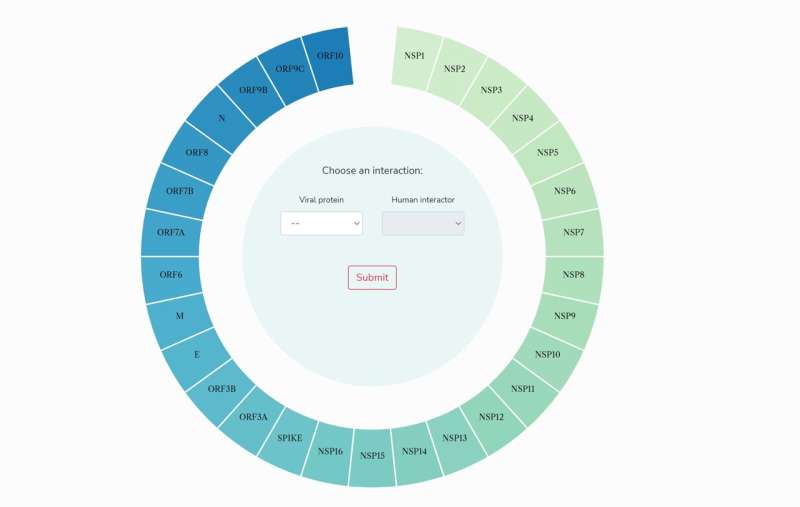New tool predicts where coronavirus binds to human proteins

A computational tool allows researchers to precisely predict locations on the surfaces of human and COVID-19 viral proteins that bind with each other, a breakthrough that will greatly benefit our understanding of the virus and the development of drugs that block binding sites.
The tool's developers have provided a user-friendly interactive web server that displays all of the protein structures, such that virologists and clinicians without computational skills can make use of the protein models to see if existing drugs, or those in development, fit into the proper binding sites.
The study, published Nov. 29 in Nature Methods, describes the tool and uses it to predict how the SARS-COV-2 diverged structurally from SARS-COV-1 (which caused a SARS outbreak in 2002-04); how genetic variation of proteins in human populations may contribute to virus-human binding and higher risk of infection; and which existing drugs show promise for binding to targets on surfaces of human proteins.
"Our computational tool allows you to see with unprecedented resolution where the viral proteins are binding on the human protein, and therefore, we can really understand what part of these proteins are key for these interactions," said Hiayuan Yu, the study's senior author and a professor in the Department of Biological Statistics and Computational Biology and the Weill Institute for Cell and Molecular Biology. Shayne Wierbowski, a graduate student in Yu's lab, is the paper's first author.
A previous study by other scientists described interactions between COVID-19 and human proteins, for the purpose of repurposing human drugs to block the virus from binding. But binding interfaces are small compared to the overall protein's surface, and previous research has lacked the detailed resolution to understand exactly where drugs might block a binding site.
"The tool we developed to predict protein-to-protein interfaces is the most accurate," Yu said, "and we can use it to make the most informed predictions for any interactions."
The pandemic spurred a surge of research worldwide to understand the structure of SARS-COV-2, with scientists using advanced imaging technologies to reveal proteins that make the virus infectious. As a result, Yu and colleagues were able to validate their computationally predicted structures against those described by others using imaging technologies.
The tool also allows researchers to predict how genetic variations in human proteins affect viral-protein interactions, as two people of similar health and age can have diverging responses to catching COVID-19, with some being asymptomatic and others showing dramatic negative reactions.
"Because of our structural models, we can predict how mutations to proteins in individuals potentially affect viral interactions," Yu said. The results could one day shed light on whether some individuals may be at higher risk due to their genetics, which could prioritize them for monitoring, vaccines and treatments.
Additionally, the tool will not only help clinicians develop drugs that precisely target human protein binding sites, it can also help reduce toxic or negative effects that could result when drugs bind to the wrong sites.
More information: Haiyuan Yu, A 3D structural SARS-CoV-2–human interactome to explore genetic and drug perturbations, Nature Methods (2021). DOI: 10.1038/s41592-021-01318-w. www.nature.com/articles/s41592-021-01318-w
Web server: 3d-sars2.yulab.org/
Journal information: Nature Methods
Provided by Cornell University





















